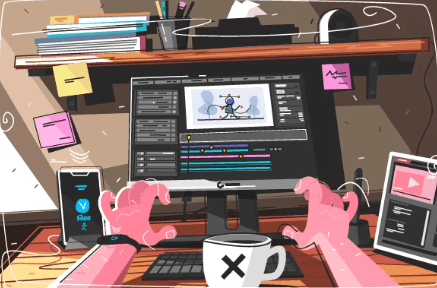The Impact of Animation on Learning and Development

The use of animation for education seems to be growing exponentially over the past decade. Primarily, it is the access to technology that has driven this change. And, the change is well-serving to the needs of students of today.
This blog is a guide on how impactful animations can be for learning and development.
Reading on you’ll discover
- Some of the most exciting benefits of using animation
- How visuals enhance our learning experience?
- How our brains recall information?
- How animations can motivate students?
- How animation in education is proving to be cost-effective?
To avoid information overload, I’ll keep the list till there.
So, if you’re excited to find out how animation can enhance learning, read on.
How good is animation for education?
As per the Visual Training Alliance, 90% of all information that is processed by the brain effectively is visual. In light of the findings, we’ve seen educators propelling forward by using visual stimuli with their lectures and class discussions.
And, more so, the trend of producing animated educational videos has picked up steam. Not only are kids excited about visual storytelling, but there are lots of raving fans who want teachers to use animation for learning.
Just like animated movies have all the amazing stories to tell, animated videos for learning can aid comprehension of practical concepts of geometric, math, geography, making it a cinch.
So, in today’s world, animations are a valuable resource for educators.
How animation for education can enhance learning experience?
People can process information with a lot more ease when the right visuals are there to aid their understanding.
If you’re struggling to teach geometry, you can consider creating animations for shapes and their angles. There’s a benefit to it. You can have it distributed across a wider audience to gain more traction on your educational content.
Educators who have produced high quality animations are already benefiting from them, and they’ll continue to do so as it’s a far better way to instill complex ideas, that too so intuitively.
So, you can also opt to create animations that improve the learning experience.
Findings of a study in 1969
This one study conducted by Dale in 1969 clearly endorses how impactful visual learning can be for kids and students in general. It sought to understand the impact on learning separately for lectures, writing, and visual content.
Here are some key findings from the study;
- Lesson recall was 25% for discussion and lectures
- For writing and reading, the recall after 3 hours was 72%, but only 10% after three days
- Recall for visual information was a surprise as students remembered 80% after 3 hours
- And, they were able to retain 65% of visual info even after passing three days
So, including visual elements in your presentations can really impact retention of information.
Brain processes visuals 60000x faster
We know that our brain is capable of translating visuals 60000 times faster than plain text. Wow! That shows why we still remember the cartoons we watched in our childhood.
But, would barely recall the lecture we had in the class last week. It is not to say that lectures are futile. But, we need to agree on the idea that lectures with visual aid are 10x better than abstract discussion.
Ones that force us to visualize, but don’t aid our imagination.
The result:
We don’t find the topic much intriguing.
Reason:
Our brains are naturally wired to translate exciting moments more easily. And, an animation in education can help us achieve just that.
Think of creating animations with an objective. When you have a clear objective of what you want to communicate, you can do it far better with animated content.
Knowing your audience will help you adjust your voice and inculcate illustrations that leave your viewers marveling at your delivery.
Not only can you instantly grab and hold their attention (of course for a longer span of time), but more importantly, you can elicit that moment of awe, where viewers tend to respond to your content emotionally.
Thus, the lessons become more fun and memorable.
How using visuals can advance development?
We know that when we want have to recall something, we start to visualize pictures of the past. We start thinking in pictures.
So, if you’ve been taught concepts using visual stimuli, forgetting things can be really hard. It’s funny, but it’s what makes visuals super-effective.
Visuals are said to enhance learning by a whopping 400%. Why is that?
Because our brain is wired to associate objects with each other. We tend to understand their relationship visually. That makes comprehension easier, as it requires minimal effort.
Besides, it’s fascinating how animations can support learners at different stages. We all can relate to visual stimuli being used to teach us the alphabets. And, today, educators have gone a step further and created a series of animations to teach children their ABCs.
Guess what? The latter is far more effective in triggering emotional response and making the experience an extraordinary one for the kids.
Using animations can make learning convenient
Animated video content also adds to convenience for students and teachers. Students can access material with a lot more ease. For those who are unable to take in-person classes, can benefit from such material being available online.
Plus, animated videos give illustrations that enhance learning, making it fun, engaging and impactful at the same time. So, if remote learning has to be sought, educators can consider inculcating animations in their presentations.
Using animations can motivate students
Animation can be a great way to motivate students. It is said that 70% of all learners are visual learners. So, forcing children to learn concepts merely by skimming texts or discussing abstract concepts, won’t do any good.
The result:
We’ve students who lack the vigor to engage and converse on the topic. So, is there a solution to motivate these students?
Yes, if they’re provided animated videos on concepts of physics, geometry, and geography and even history, discussions would be more engaging, and far easier to recall, when asked to.
Just imagine how easy it would be wrap our heads around those concepts.
Animated content can inspire communication
A big reason why teachers need to pay attention to animation for education is communication. Animated delivery inspires communication of ideas, effortlessly. Animation takes difficult subject matters and make them easy.
As said earlier, visuals can be processed at a far greater speed than texts. So, it pays more to consider using animated presentations to illustrate concepts.
One good practice is to use characters and tell stories. Playful and funky characters might work well for kids, but if you’ve to present to a more mature or let’s say professional audience, you’ll need professional avatars.
And, when communicating, it would really help if your ideas are imaginative, and your messaging more intuitive. You don’t want the audience to fail at second guessing.
So, make sure they can easily resonate with your characters and their stories.
There are lots of video animation companies that are helping educators to produce such educational videos.
These are attractive, and thoughtful, and can leave a mesmerizing touch on the learners. All you can have to do an educator is to share details on your demographics, and they’ll do the rest.
Animated content production is cost-effective
Unlike texts and lectures, animation can have a long shelf life. A uniquely designed character story can be used for years, allowing you to yield a healthy ROI on the content.
Besides, animations are a cost-effective way to bring a course online.
Unfortunately, most people take it as a rip-off in contrast to videos and lectures. But, if you take into account the efficacy of animated learning videos, you might just want to produce more of these.
And, for the cost, animated delivery sets you apart from what others are offering. At the same time, it’s effective and attractive to learners. So, they would come after it. Assuming you can distribute at a greater scale, the cost of production shouldn’t bother you.
Interestingly, when you create animated videos, you build characters and environments once.
These can be used as long as you want them in your presentation. This can go on and on for another several modules, keeping the cost down and the process efficient as you progress further.
You can always hire for animated video production services to grow your ROI in no time.
Final thoughts
Let’s wrap this one up. Above we discussed some amazing benefits of using animation in education. We highlighted that the trend of using animation for educational purposes has picked up steam.
And, it won’t slow down any sooner. Using animated videos, you can make learning convenient, attractive and much more motivating for most students.
On top of that, you can also benefit from it as a cost-effective resource for educational material. As these videos tend to stick around for years and happen to instill ideas and study concepts far better than any other method in teaching.








